|
Thread Number: 11920
The first Power Nozzles - History, Queries and Suppositions. |
[Down to Last] |  |
| Post# 127805 3/18/2011 at 22:47 (4,879 days old) by aeoliandave (Stratford Ontario Canada) | ||

Triggered by recent discussions both here and over at Brother Club Washerland about the Lewyt Electronic Motorized Beater Sweeper power nozzle I've found myself idly thinking about them, who was first to market, etc.
To begin, I was asked why production of GE Roll-Easys didn't last very long for such a clever design. They were made from 1955 until at least 1960...any word on when production ceased? Why cease production? Well, a 5 year run of a design is not unusual to recoup development costs before introducing a new innovation-laden model. This was the high-rolling Spaceage-New 1950s...just look at car designs which modified practically annually. The Roll-Easy used unique and expensive-to -produce gusseted wrap-around-the-motor paper filter bags unlike any other vacuum or even GE tub canisters. This is one expense GE could eliminate by concentrating on the Reach-Easy 'Swiveltop' models, adding a plug-in socket for their late-to-the-party PN. (When did GE introduce a Power Nozzle?) In addition, tugging & lifting the Roll-Easy around the house as shown & suggested in the manual took a mighty toll on the extremely flexible single-wall turquoise vinyl hoses, which tore and split with alarming frequency if one was not careful. The GE Service dealership replacement hose for the Roll-Easy was a standard GE wire coil rubber wrap jacketed in a woven cloth or vinyl outer sheath, as were most other vacuum hoses in the Industry at the time. These hoses, while not as flexible, are much longer lasting. I'm thinking Hoover was first to market with a solid walled vinyl-sheathed coil hose with their Duraflex and Ultraflex for uprights, cylinders and Constellations. (?) (The Westinghouse T-4 and T-6 cylinders also had a coiled plastic-y vinyl hose) Yet, I think primarily the Vacuum Industry's development of the independently motorized Power Nozzle with rotating brushroll, attached to long wands, changed everything. Motorized Power Nozzles: The first such power nozzle that comes to mind (other than early 1900s central vac power nozzles I've heard about) seems to be the Lewyt Big Wheel Electronic Model 107-E in Nov 1958. Electrolux USA followed with their PN-1 in 1959...1961 on Canadian Luxs. All of these early PNs had a long AC power cord that clipped externally to the wands and hose, plugging in to a socket on the vacuum body near the hose inlet coupling. Electrolux used a two pin arrangement while the Lewyt had a regular two-blade wall socket type plug. Either plug would have been problematic on a Roll-Easy, which rotates almost 300 degrees front to back on its side wheels and the stretchy hose would have easily pulled the plug free. The sideways cant of the first convex R1 into walls and doorways under 'pullage' by the off center inlet wasn't too helpful either in this hose strain regard. Electric Hoses: The first internally electric hoses for PNs was probably the Lewyt Model 111 in 1959..that didn't work out so well. :-) Hoover dangled its toe in electric hose waters with the January 1959 Garland Green Constellation Model 77 that used the handle switch to turn the fan motor on and off - no PN was created or offered. Development was no doubt deferred due to Lewyt's troubles. Electrolux USA seems to have introduced its first integrated electric hose with pigtails in 1969/70 on the 1205, eliminating the pigtail in 1972 with contacts on the hose coupler. Electrolux Canada brought out its electric hose with pigtails in 1969/70 for the 88/89 Series also but did not go pigtail-less until the 1973 all new plastic bodied AP100. Back to early Power Nozzles: Compact had a nice looking unit- the ABC (Always Beauty Clean) but I have no idea what year it was introduced. It looks identical to the wedge-shaped Kenmore PN. Again no idea what year - though we can surmise 1959 because of the turquoise wrinkletone textured paint - nor who manufactured it or for whom - IEC or Whirlpool for Sears and Compact. Michael G. Anderson's site has a wealth of information about early Power Nozzles - see link. CLICK HERE TO GO TO aeoliandave's LINK 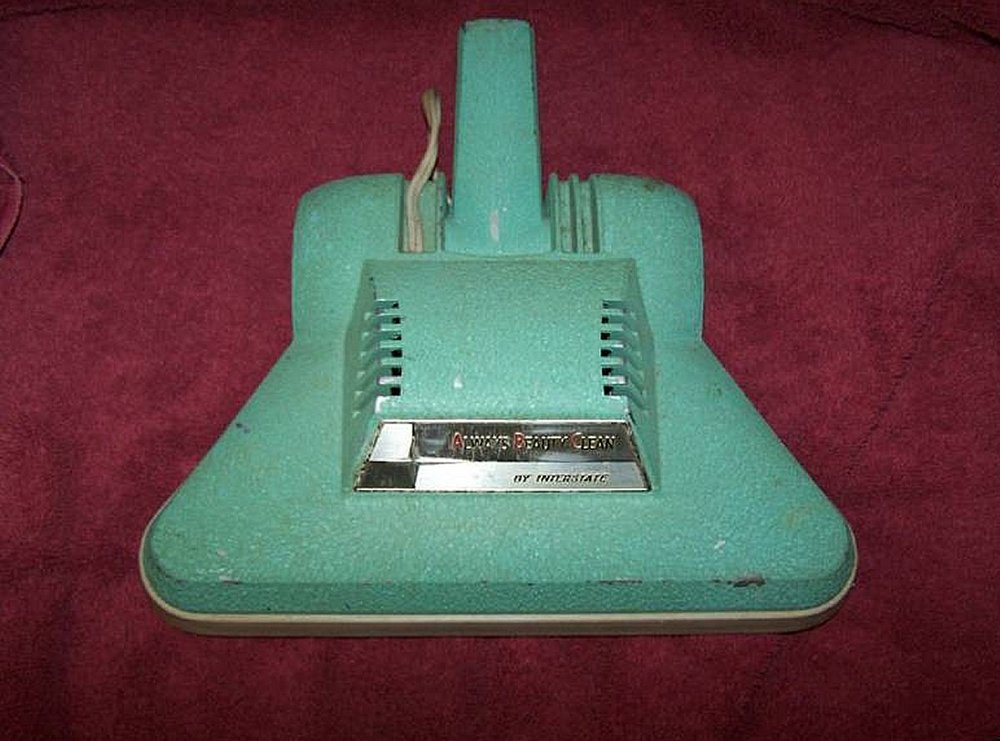
This post was last edited 03/18/2011 at 23:51 | ||
| Post# 127825 , Reply# 1 3/19/2011 at 10:25 (4,878 days old) by collector2 (Moose Jaw, Sk) | ||
 | ||
| Post# 127826 , Reply# 2 3/19/2011 at 11:13 (4,878 days old) by aeoliandave (Stratford Ontario Canada) | ||

No, I didn't forget the absolutely brilliant Air-Way PN systems, which they continued to develop through many models. Air-way Charlie has most if not all of them and I hope he will chime in at some point. Tom Gasko has the PN Air-ways at the Tacony Vintage Museum, too.
But to me the multi-purpose 1930s Air-Way is a singularly unique 'dirty fan' vacuum system overall, being an upright configuration that has the valve option to direct airflow through the fan from either the power nozzle or down the hollow handle to which one could connect a hose and handtools. Also, the Power Nozzle was not intended to be detached from the general purpose machine (although these Air-Way 'stick-vacs' are quickly disassembleable.) Yeah I just made up a word. LOL Being decades earlier on the scene I'm perplexed why the other vacuum manufacturers didn't adopt the motorized brushroll floor nozzle earlier than the late 1950s. Perhaps it was a Patent infringement issue (and that pesky WW2 delay) or cylinder & canister vacuums moved on to much more powerful motors and turbine fans behind the dustbag airflow, keeping belt-driven brushrolls for uprights and their less powerful impeller fans? But it brings up a good point - initial Electrolux patent application dates from the 1940s show that they were first considering an Air-Way type setup, with drawings of cylinder vacuums having a power nozzle head attached directly to the intake port, and a tall removable handle attached to the back of the vacuum body for steering and propelling across the floor, turning a cylinder into a heavy upright. Someone had a brainstorm and realized the common sense approach of making an entirely independent and removable lightweight accessory power nozzle on a stick wand so Milady could still use her hand tool accessories at the end of the hose. When I get back from lunch I am going to post some of these interesting patent drawings. Here's what Lewyt had in mind as early as 1957, clearly based on and evolved from their 1950 Carpet Sweeper Floor nozzle. Electrolux didn't file their PN design concept patent until 1959. Dave 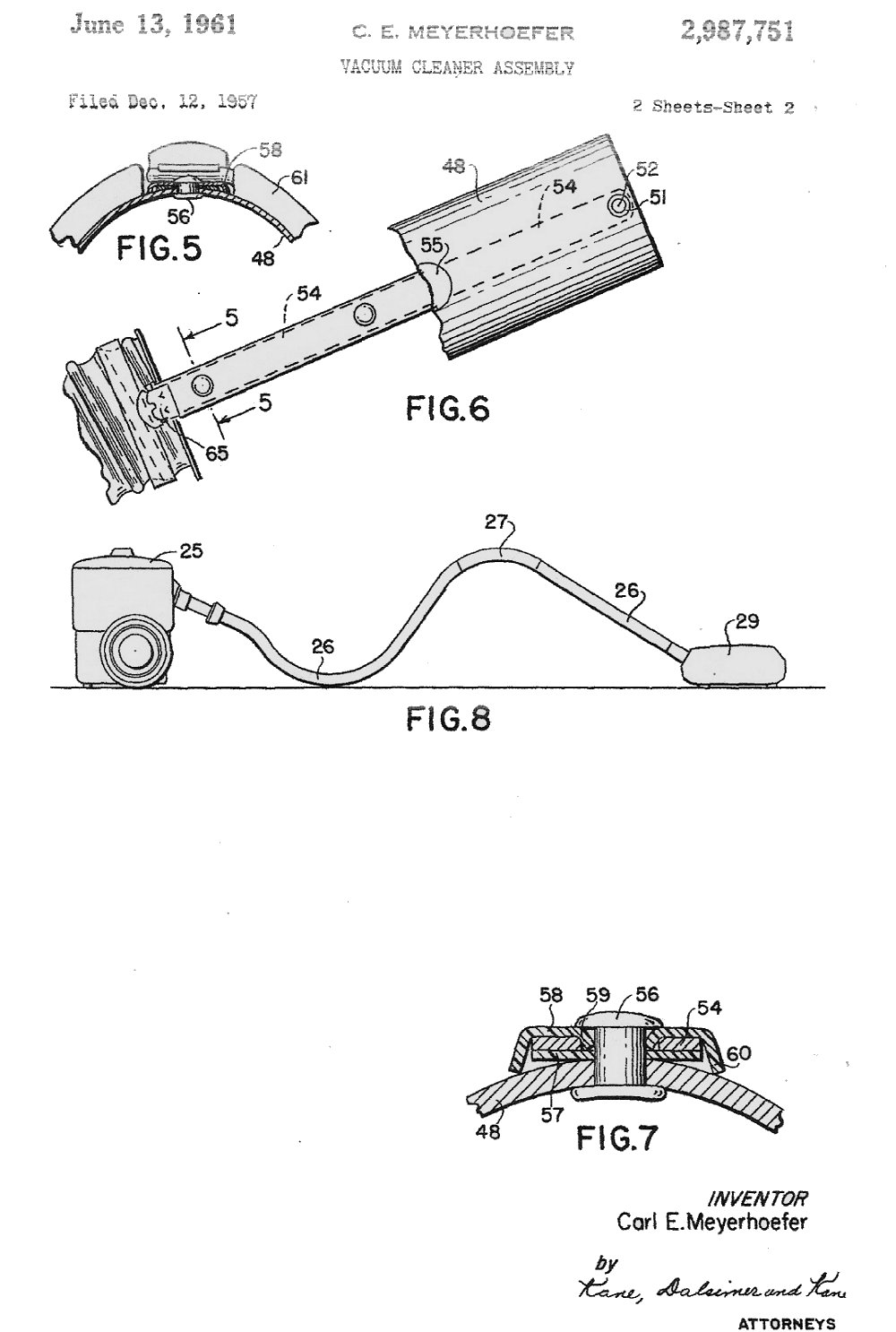
| ||
| Post# 127827 , Reply# 3 3/19/2011 at 11:21 (4,878 days old) by aeoliandave (Stratford Ontario Canada) | ||
 | ||
| Post# 127828 , Reply# 4 3/19/2011 at 12:14 (4,878 days old) by sireluxomatic () | ||
|
Not exactly about a power nozzle, but part of the system: did any manufacturer ever make or offer an electric hose that fully swiveled on both ends? Have never seen or even heard of such a creature. | ||
| Post# 127833 , Reply# 5 3/19/2011 at 18:03 (4,878 days old) by andken23 () | ||
|
i never heard of first lewyt power nozzle before until now. Andrew | ||
| Post# 127836 , Reply# 6 3/19/2011 at 18:58 (4,878 days old) by vac_whisperer () | ||
|
A few things: 1: Ive been thinking about posting a topic asking about what the first power nozzles were, but you beat me to it! :P Thanks for answering a lot of questions! 2:I never knew lewyt EVER made a power nozzle! VW | ||
| Post# 127838 , Reply# 7 3/19/2011 at 19:02 (4,878 days old) by aeoliandave (Stratford Ontario Canada) | ||
"did any manufacturer ever make or offer an electric hos
Not that I've heard of, Bob, but with the Lux electric hose swiveling freely at the pistol end why would one need the other end to swivel too?
The USA Lux pigtail hose (AE & G) does rotate within the inlet throat until either the pigtail or external clipped cord winds tight. The Canlux 80 series hoses with the ball bearing coupler overcomes this binding rotation with a plastic coupler cap that snugs over the bumper strip protrusion - standard on the pigtail electric hoses with handgrip trigger switch sometime in 1968. Was there a USA pigtailed electric hose for the G type machine? Mr Lester's site indicates the pigtail version did not appear until the mid-run 1970 1205, which changed to the new blade-connection electric hose in 1972. Both later Electrolux electric hoses (AP and 1205 series) cannot rotate because the hose's power connector blades engage with contact slots within the inlet. But all the hose pistol handles freely rotate, with double contact bars riding on two circumferential rings. You know this but of course I'm over-explaining for everyone who may not have taken an electric hose apart. :-) The regular Lewyt Big Wheel hose has 360 degree rotation at both ends (the inlet coupler being twist & lock with it's own swivel connection) so this holds true for the 107 Electronic with the external clip on cord. Never having examined one I don't know if the hose for the Model 111 and 121 swivel at all. Maybe if Toby is reading this thread he can enlighten us...with lots and lots of detail pictures, please. :-) Dave 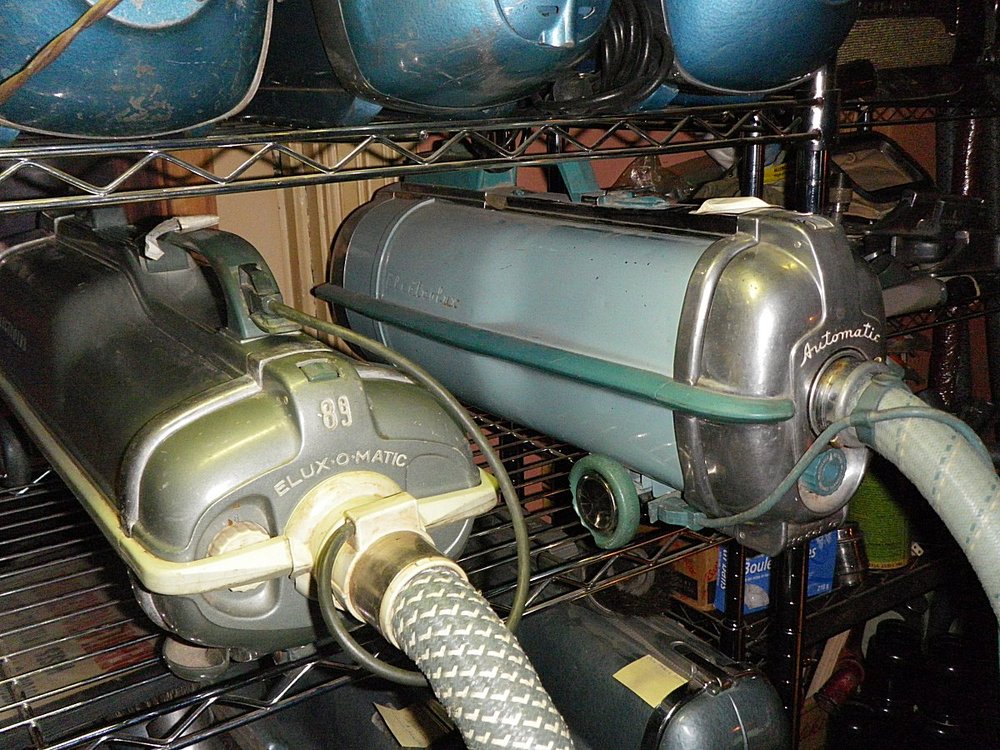
| ||
| Post# 127841 , Reply# 9 3/19/2011 at 19:34 (4,878 days old) by aeoliandave (Stratford Ontario Canada) | ||

Canadian Electrolux Power Nozzles and hoses from the Owner's manual:
The red Models 86 and 88 - versions 2 w all around bumper strip - have an external clip-on cord that plugs into the capped recess in the front of the handle. The PN-1 molded in cream plastic imported from the USA was trimmed with a red rubber bumper. 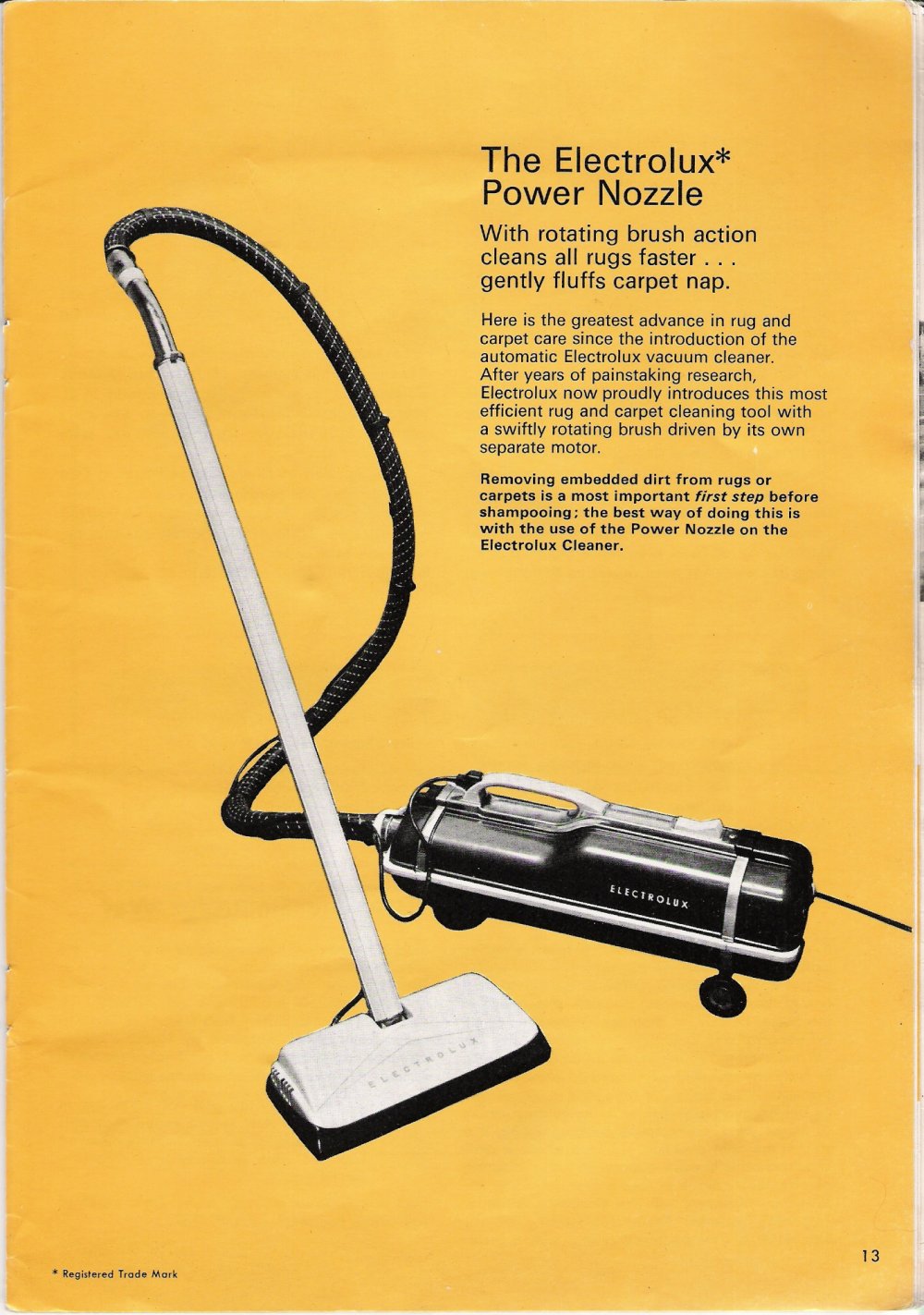
| ||
| Post# 127843 , Reply# 10 3/19/2011 at 19:38 (4,878 days old) by aeoliandave (Stratford Ontario Canada) | ||
 | ||
| Post# 127845 , Reply# 11 3/19/2011 at 19:45 (4,878 days old) by aeoliandave (Stratford Ontario Canada) | ||
 | ||
| Post# 127846 , Reply# 12 3/19/2011 at 20:00 (4,878 days old) by aeoliandave (Stratford Ontario Canada) | ||
 | ||
| Post# 127847 , Reply# 13 3/19/2011 at 20:04 (4,878 days old) by aeoliandave (Stratford Ontario Canada) | ||

Newsflash from my archives.
Here's a quote from Doug Smith: 'The 89 had 3hree different power nozzles during its reign. Starting with the PN2 (Canadian designation for the lime green US made PN1), the next 2wo power nozzles were a strictly Canadian design. The PN3 was lime green with a dark green bumper and featured a control that allowed the user to lower the brushroll when it became worn (not really a height adjuster per se - the bottom plate rode across the carpet at the same level). The PN4 was basically the same in dark green with a lime green bumper, and did away with the adjuster control.' 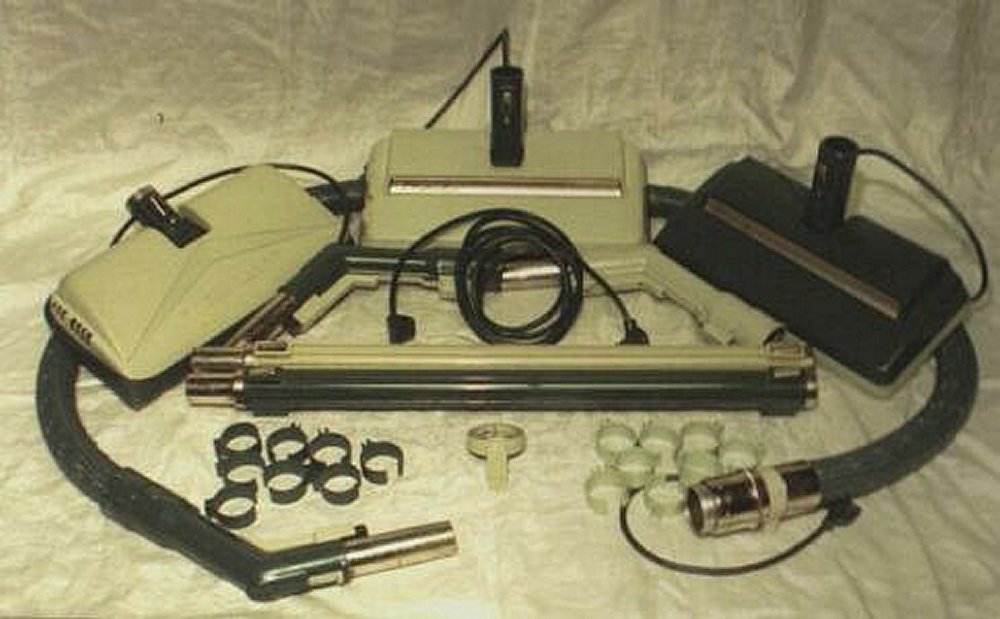
| ||
Post# 127852 , Reply# 15 3/19/2011 at 20:28 (4,878 days old) by Air-WayCharlie  (USA) (USA) |
||
Dave
There is not much to chime in on here! You and the other folks are covering everything very well. Air-Way only made 2 twin motored uprights--the Chief, (mine is pictured in a thread in this post), and the Super Chief. It is, "rumored", another model existed but no pics have ever surfaced.
Air-Way did make another revolving brush upright, the DirtMaster, but it was a single motor twin fanned machine using two belts. One was unique at the time as it was a V belt, the other a traditional flat belt. A very powerful, albeit somewhat clumsy vacuum that is very unique in design. These vacuums are the, "hen's teeth", and I am fortunate to have a near pristine one. Pics may be found on this site. One must remember a couple of things that may be important or not important about the advent of power nozzles and the time frames. First, the Air-Way's were VERY expensive for the era. The Chief and Super Chief are approx. circa 1936-37. I'm not at home so I do not have the literature in front of me. The country was in the middle of a depression and vacuums with a revolving brush were not a high priority. I would opine that the wealthy at that time were the buyers. Those vacuums were competing with the Hoover 150 at the time and remember, the name, "150", came from the financing of $1.50 per week or maybe it was per month to afford the vacuum. Regardless, the 150's and the Air-Way's were competing with each other. Both featured revolving brushrolls with, "beater bar", type agitators. Air-Way had the cut above--twin motored with the revolutionary wood pulp cellulose disposable paper bag! One motor for suction and one to operate the beater bar. AND, with a disposable bag that provided incredible filtration. How innovative is that? They were so far ahead of the time. The other consideration about the advent of the power nozzle is two-fold: It could have have had something to do with WWII coming along and changing the face of the world. The other part of that is the cleaning needs of America. In the 1930's and well into the next two decades most homes were not wall to wall carpeted. They were hardwood floors with oriental rugs, braided rugs or something along those lines. Just what was the need for a power nozzle as we know it today? Yes, it was very do-able for Hoovers but there was an ugly lawsuit against Air-Way and their production of revolving brushroll vacuums was halted. When Air-Way started manufacturing vacuums post WWII it introduced the model 55 which was the purple straight suction vacuum. The era of a revolving brush upright vacuum was over for Air-Way. They did introduce a power nozzle late in the 1960's, but, that is another story in, and of itself. Plus, at that time they were a little late in the game. For many homes, a straight suction vacuum fit the bill perfectly. The rugs were for the most part, tightly woven and a rug tool would do the trick. Slip on a floor tool and the hardwoods were all set too. In the 1950's, the wall to wall carpet craze started and hence you see the, "power nozzle", come into play for a stretched wool rug nailed to the floor. A straight suction vacuum was just not going to work very well. Later, the wool became synthetic material and it still needed a good revolving brush. Just a little more food for thought! Charlie | ||
| Post# 127853 , Reply# 16 3/19/2011 at 20:29 (4,878 days old) by aeoliandave (Stratford Ontario Canada) | ||
 | ||
| Post# 127854 , Reply# 17 3/19/2011 at 20:41 (4,878 days old) by aeoliandave (Stratford Ontario Canada) | ||

The brown PN V would have been for the AP 280 series, Doug?
I was under the impression that CanLux switched entirely to the USA style PNs as shown on the AP100 manual. I have a yellow USA-style one for an AP in yellow labeled a PN200 but don't have the vacuum - Pete does. The AP100 PN is labeled a PN100. 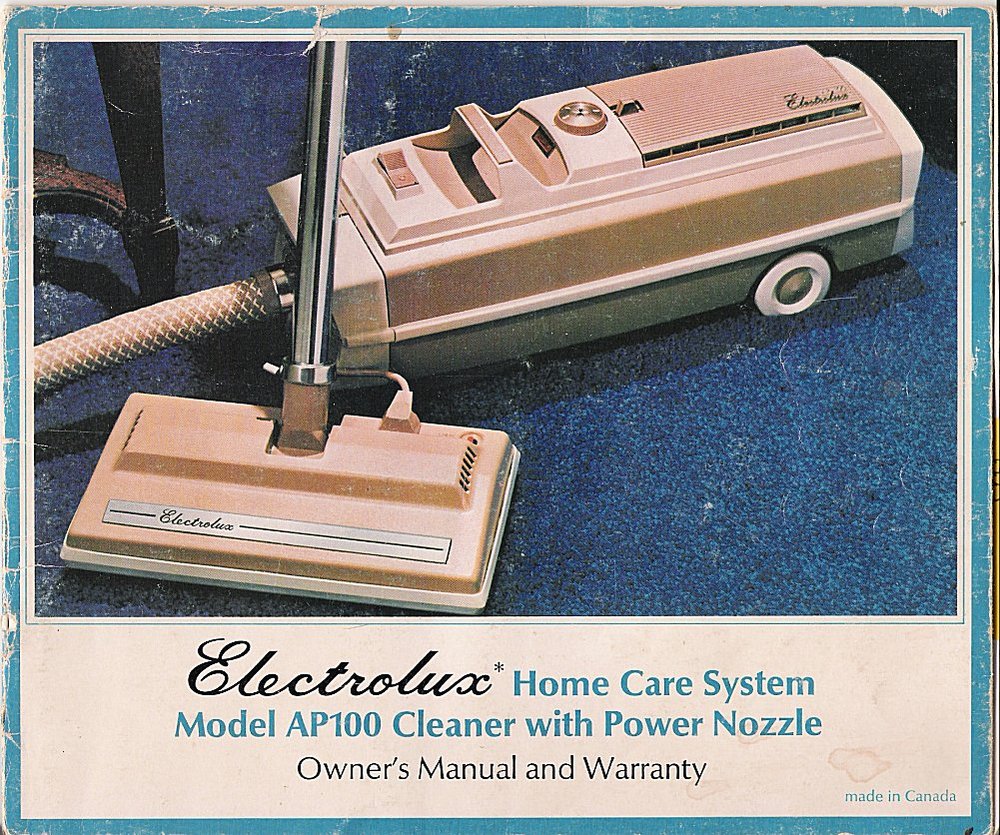
| ||
| Post# 127856 , Reply# 18 3/19/2011 at 20:54 (4,878 days old) by aeoliandave (Stratford Ontario Canada) | ||
 | ||
| Post# 127859 , Reply# 20 3/19/2011 at 20:55 (4,878 days old) by aeoliandave (Stratford Ontario Canada) | ||
 | ||
| Post# 127861 , Reply# 21 3/19/2011 at 20:59 (4,878 days old) by aeoliandave (Stratford Ontario Canada) | ||
 | ||
| Post# 127863 , Reply# 22 3/19/2011 at 21:02 (4,878 days old) by aeoliandave (Stratford Ontario Canada) | ||
 | ||
| Post# 127864 , Reply# 23 3/19/2011 at 21:03 (4,878 days old) by sireluxomatic () | ||
|
Seems like this design morphed into the 80's Electrolux uprights (with the exception of the bypass dirt fill tube). | ||
| Post# 127865 , Reply# 24 3/19/2011 at 21:04 (4,878 days old) by aeoliandave (Stratford Ontario Canada) | ||
 | ||
| Post# 127866 , Reply# 25 3/19/2011 at 21:05 (4,878 days old) by aeoliandave (Stratford Ontario Canada) | ||
 | ||
Post# 127867 , Reply# 26 3/19/2011 at 21:06 (4,878 days old) by Air-WayCharlie  (USA) (USA) |
||
Dave,
I have some very rare, most likely, not seen before diagrams of various versions of Air-Way's with twin motors that never came to fruition. They came my way by various folks that used to be in high places with Air-Way.
When I return home, I will scan them and post them. They may even end up in a newsletter some day! It is amazing what the Air-Way engineers came up with at those particular time frames. Charlie | ||
| Post# 127868 , Reply# 27 3/19/2011 at 21:09 (4,878 days old) by aeoliandave (Stratford Ontario Canada) | ||
 | ||
| Post# 127869 , Reply# 28 3/19/2011 at 21:11 (4,878 days old) by aeoliandave (Stratford Ontario Canada) | ||
 | ||
| Post# 127870 , Reply# 29 3/19/2011 at 21:41 (4,878 days old) by andken23 () | ||
|
well in vintage electrolux power nozzles i only got the pn4 USA. Here is a picture of it with the wand. Andrew 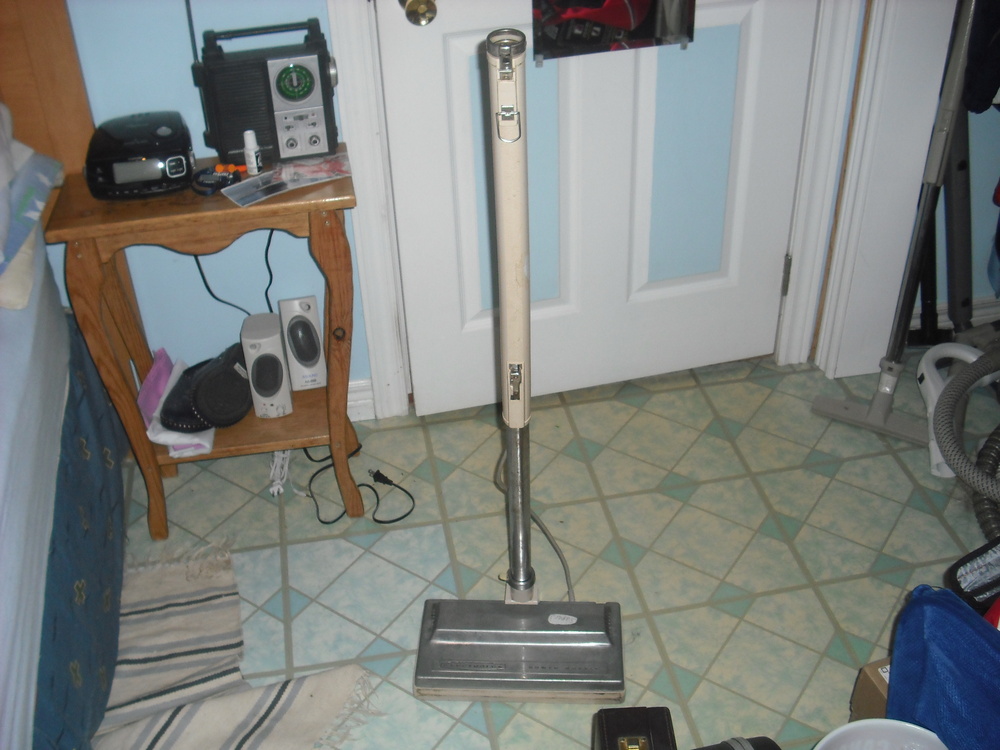
| ||
| Post# 127871 , Reply# 30 3/19/2011 at 21:49 (4,878 days old) by aeoliandave (Stratford Ontario Canada) | ||

This thread is so much fun and for trivia-obsessed me what the Forums are all about. Thanks, guys for your generous enthusiasm for but one aspect of our beloved vintage vacuums.
There's much here that informs the evolution to contemporary power nozzles. So, Lewyt Model 107-E wins with the first detachable motorized Power Nozzle in 1958, Air-Way having shown the way. Electrolux wins 2nd Prize in 1959 by sticking with 115 AC volts. Hoover, I'm sure, had a PN in the testing stages to follow up the 1959 Constellation 87 electric hose but late to the market, the timing was all wrong with the Lewyt cascading disaster through 1959-60 as the 'improved' low voltage Model 111 versions deteriorated and failed with shocking results. Consumers and Dealers would have been aware of the lawsuit and would have been leery of something similar, even from Hoover. Advertising departments would have been working overtime to to overcome the Lewyt stigma yet would have wanted to trumpet their All New Electric Hose and Power Nozzle. Here is the McCalls magazine ad for the late 1958 Model 111. Note the cordless wands and hose - this is the low voltage model. "Beats, Cleans, Fluffs Rugs...Without Wires...Without Batteries!" 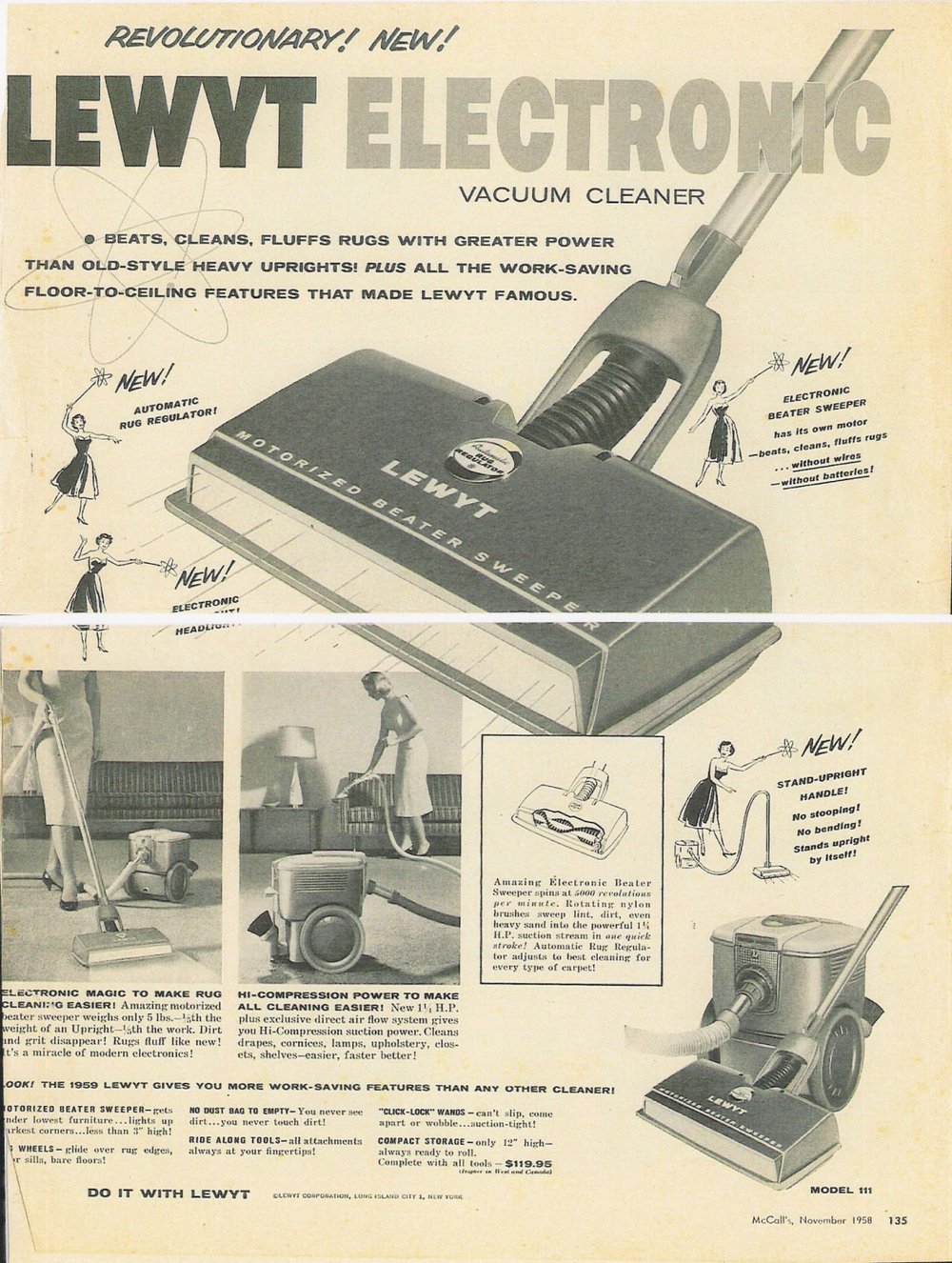
This post was last edited 03/19/2011 at 22:21 | ||
| Post# 127872 , Reply# 31 3/19/2011 at 21:56 (4,878 days old) by aeoliandave (Stratford Ontario Canada) | ||
 | ||
| Post# 127873 , Reply# 32 3/19/2011 at 22:00 (4,878 days old) by aeoliandave (Stratford Ontario Canada) | ||
 | ||
Post# 127874 , Reply# 33 3/19/2011 at 22:11 (4,878 days old) by Air-WayCharlie  (USA) (USA) |
||
"Shocking results".............. | ||
Post# 127875 , Reply# 34 3/19/2011 at 22:12 (4,878 days old) by Air-WayCharlie  (USA) (USA) |
||
BTW, | ||
| Post# 127876 , Reply# 35 3/19/2011 at 22:20 (4,878 days old) by electrolux~137 () | ||
Let's not forget...



| ||
| Post# 127877 , Reply# 36 3/19/2011 at 22:36 (4,878 days old) by aeoliandave (Stratford Ontario Canada) | ||
 | ||
| Post# 127878 , Reply# 37 3/19/2011 at 22:38 (4,878 days old) by aeoliandave (Stratford Ontario Canada) | ||
 | ||
| Post# 127879 , Reply# 38 3/19/2011 at 22:42 (4,878 days old) by aeoliandave (Stratford Ontario Canada) | ||
 | ||
| Post# 127880 , Reply# 39 3/19/2011 at 23:25 (4,878 days old) by midcenturymike () | ||
|
I came across these last summer, quite unexpectedly, while shopping for some unrelated item. I was wondering why the green one looked like it had an additional "1" stamped into the metal base-plate beside the PN1. Its all so clear to me now. 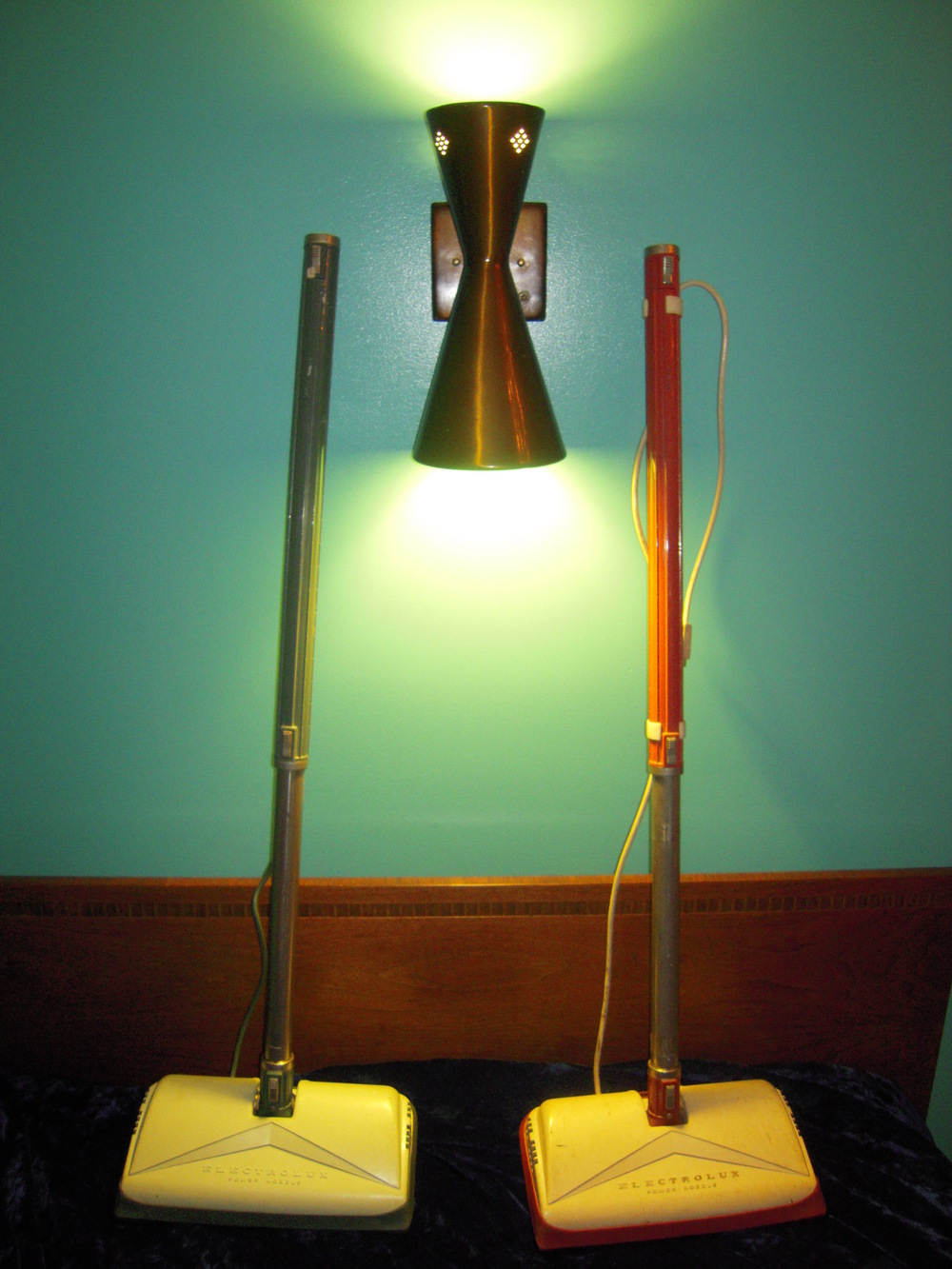
| ||
| Post# 127890 , Reply# 40 3/20/2011 at 08:39 (4,877 days old) by aeoliandave (Stratford Ontario Canada) | ||

Awww Jeez, Mike!
Could there be a more lovely picture to a Canadian Electrolux fan than both 80 series PN-1s side by side...with matching telescopic wands, no less! And to top it off, artfully posed under a smashing wall sconce against a turquoise wall. Extra Yummy and Pic Of The Day worthy, I'd say. Great pickins there down Windsor way for a sharp-eyed fellow, no doubt a legacy of the Auto Industry heyday both sides of the St Clair river. I'm stoopid curious now. Does the red telescopic have an embedded PN cord channel up the back, like the green one? Or is it empty? Or what? Picture please. The first red non-electric telescopic for 83s, 86s and 88s was a smooth all metal half aluminum construction with a sprung friction ring connection (in the manner of USA ring) also used on the floor nozzles. This was well before the changeover to the latch catch and PN-1, so wand clips would be a must. That would make it easy to detach the PN and cord for straight wand use. Simpler style floor nozzles had a push-tight fit that made the tools easy to knock off with your shoe, or fall off under vigorous vibration. But your red 89 style telescopic has the new-style pushbutton latch so familiar on the green 87/89. I don't have nor have seen red tools with the latch catch. ??? Hey Doug, which came first for the Red nozzles...the 'insert, push & twist' or the angled friction ring? Just curious about the details. Dave, drooling... 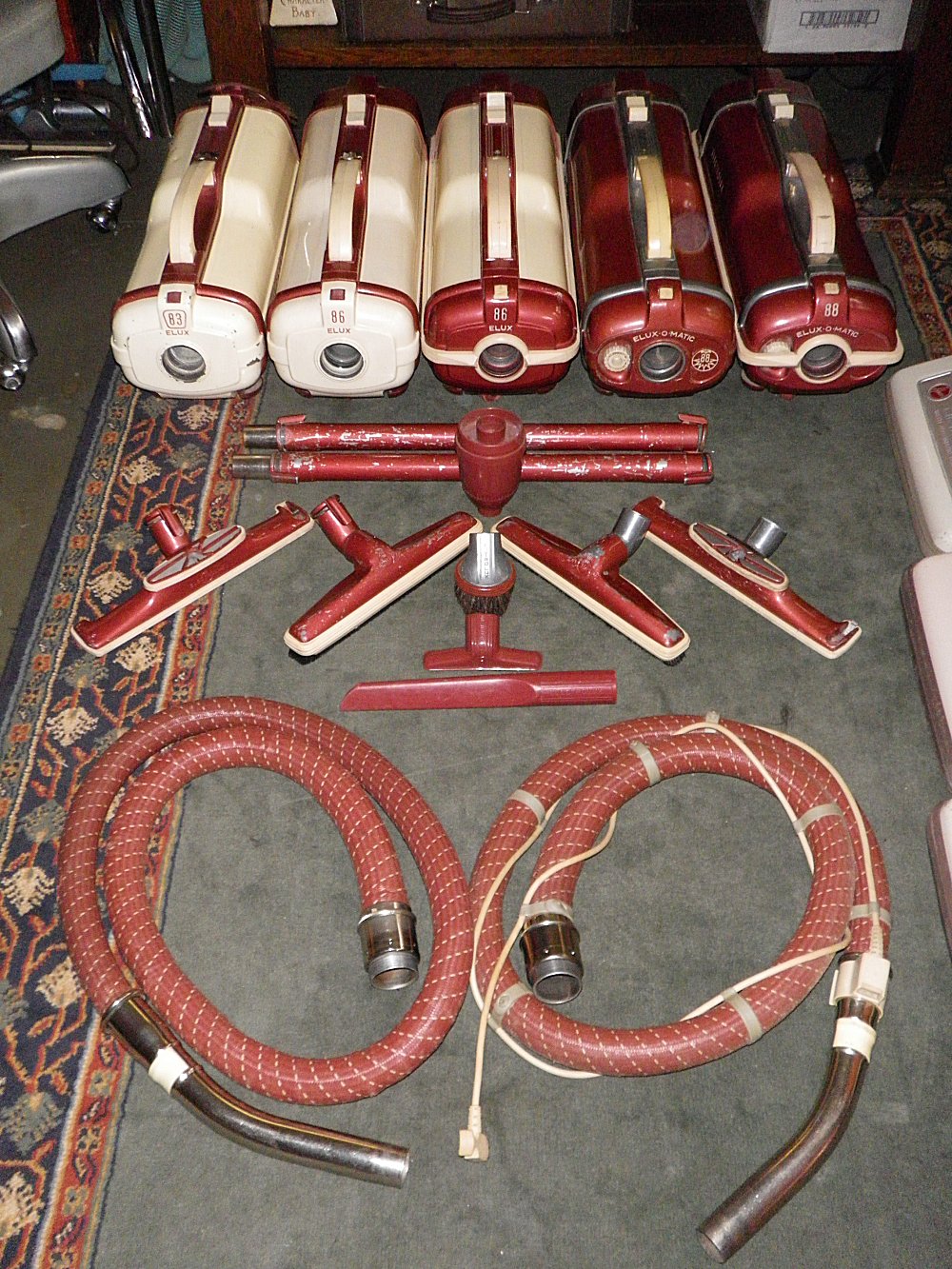
| ||
| Post# 127901 , Reply# 41 3/20/2011 at 10:47 (4,877 days old) by aeoliandave (Stratford Ontario Canada) | ||

Another RCA Whirlpool advert from the Lester Files.
And a mea culpa correction. Whirlpool wins second prize (after Lewyt's 1957 Model 107) since New For 1958 is right there...duh...on the brochure cover. :-) Sorry Electrolux, you are demoted to 3rd, maybe 4th place dependent on a confirmed date for IEC's Compact ABC. :-( 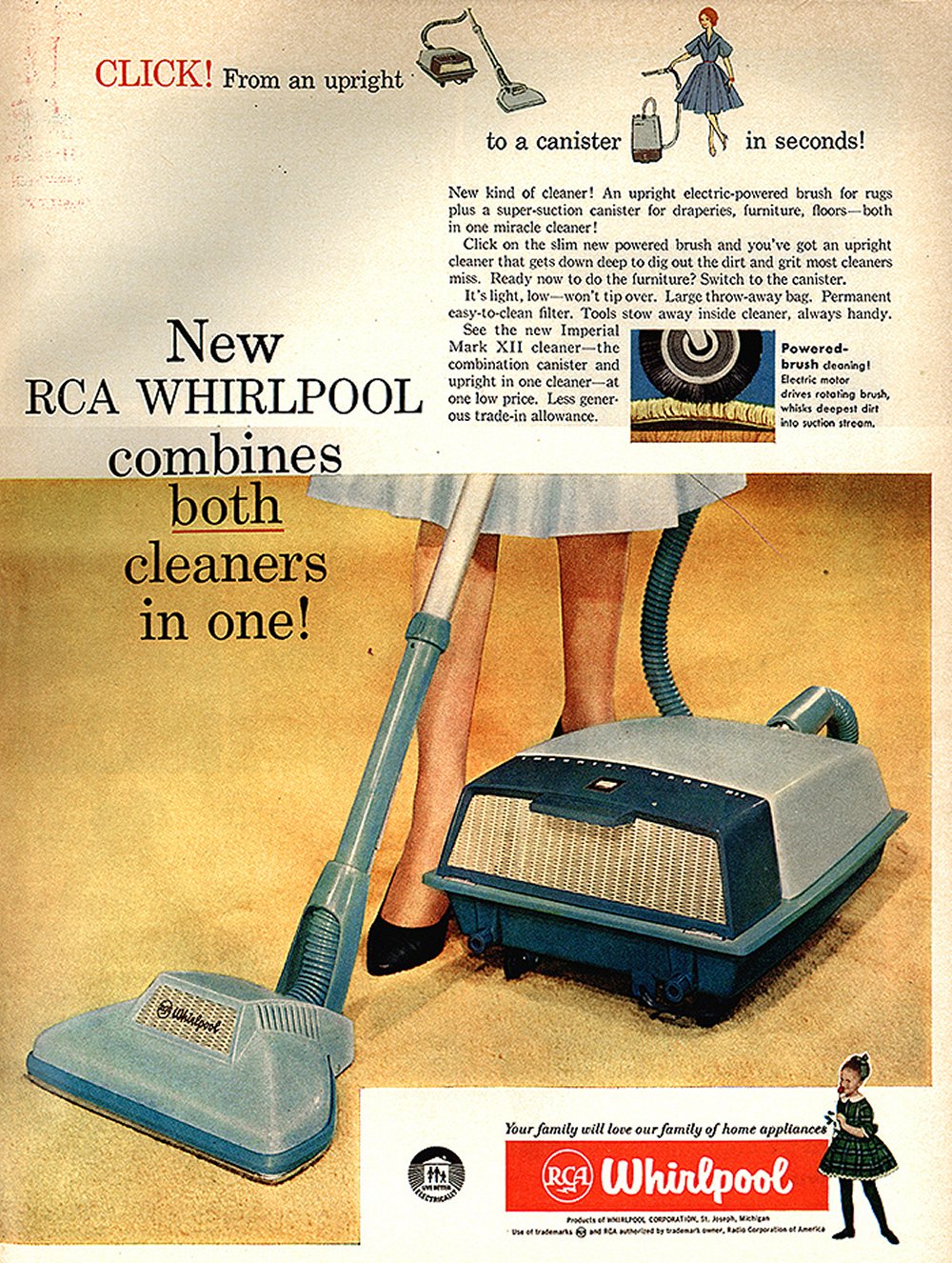
| ||
| Post# 127904 , Reply# 42 3/20/2011 at 11:06 (4,877 days old) by portable (Corvallis, OR) | ||
 | ||
| Post# 127921 , Reply# 45 3/20/2011 at 11:47 (4,877 days old) by sireluxomatic () | ||
|
PN II #2 That's about as upright as this gets (leaning against the wall). Fascinating thread, I must say. Nothing better than trivia, minutiae, and speculation, not to mention, via more knowledgeable people than myself, confirmation :) 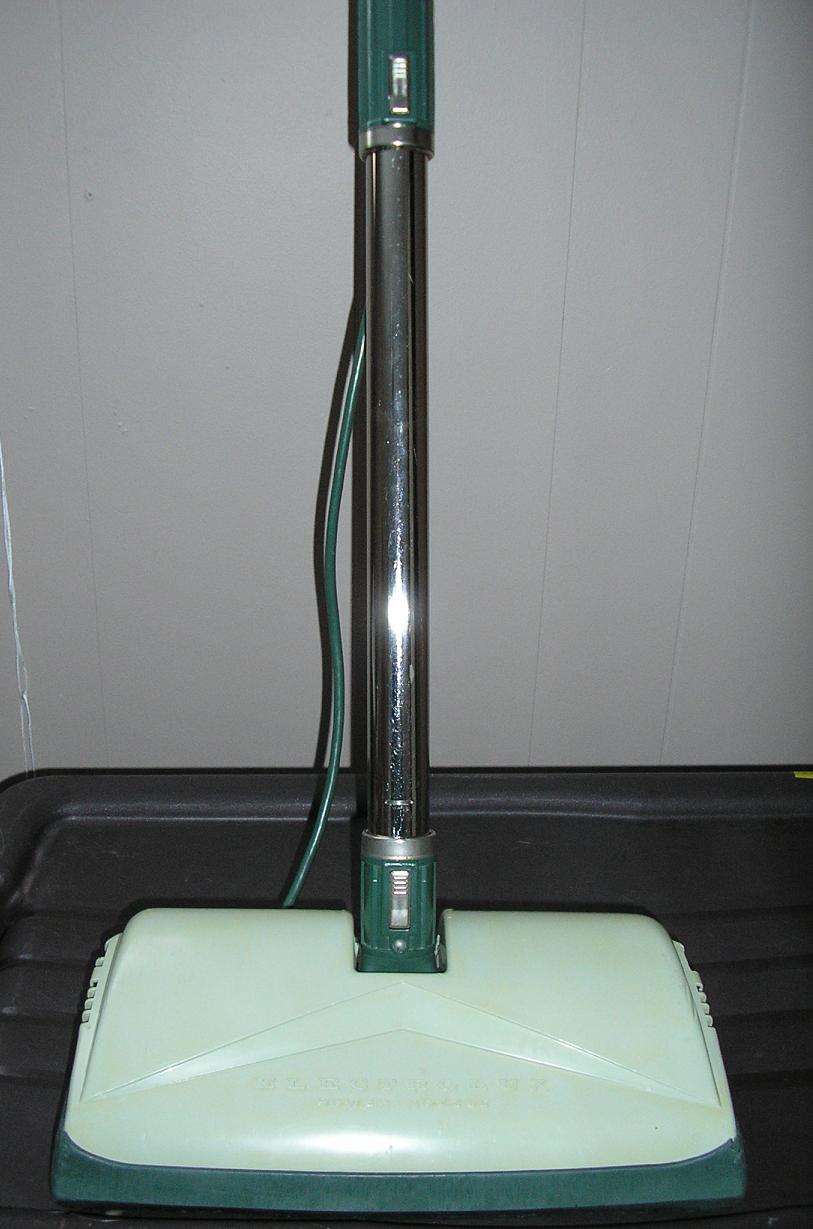
| ||
| Post# 127942 , Reply# 46 3/20/2011 at 14:16 (4,877 days old) by collector2 (Moose Jaw, Sk) | ||

Hey Dave:
Too many questions. I'm probably going to miss some but here goes. 1 - the chocolate brown PNV - This was never sold as a powerhead. The parts were produced to make a powerhead to match the brown trivac as they had a large overseas order for trivacs with the powerhead. Unfortunately who ever made the order backed out before they were even fully assembled so they were shipped to branches as replacement parts for the PN V's. So the only ones you will see are ones that were used for repairing the green or tan power heads. 2 - The spring clip nozzles were on the 2nd version of the 86/88 3 - the first red PN1's had the long white handle, later ones had the red telescopic wand with the cord clipped to the back. When the 89's were out red pn1's with a telescopic wand and the cord built into the wand were produced to retro fit older machines. Doug | ||
| Post# 128058 , Reply# 47 3/21/2011 at 18:15 (4,876 days old) by aeoliandave (Stratford Ontario Canada) | ||

Thanks, Doug!
Now, calling all IEC Compact Pundits in a quest identifying and dating the ABC Power Nozzle...someone won this on eBay in January 2009. Bidding was fierce iirc. Was it one of us? Come out, come out, whoever you are... If the IEC Compact chart is more or less correct, and I have no reason to think it is wildly inaccurate, Compacts can be generally dated by the Model No consistently cast into the bottom of the magnesium shell. More precise dating comes from the decorative graphic Anniversary Decal often applied to the opposite side of the vacuum from the chromed 'Compact' script. The yearly count begins in 1937 with the founding of IEC - Interstate Engineering Corporation - although the first vacuum sold to the public, The C-1, came out in 1946. Compacts were and are sold only door-to-door by Salesmen to the present day, as the Tristar. Thus: C-1 - 1946-48 C-2 - 1949-54 - 25th Anniversary 1952 C-3 Revelation - 1949- 54 - sold only in retail stores C-4 - 1955-58 C-5 - 1959-60 C-6 - 1961-70 - early ones have a single front ball caster, two thereafter. C-7 - 1971-72 - now called the Compact Electra (?) But then so many early logos have broken off and been replaced. C-8 - 1972-78 No model designation but known in the hobby as the C-9 - 1982-85 - sometimes labeled TriStar. The name changes to TriStar with the 1986 50th Anniversary Model CXL What follows is speculation based on 11 Compacts in my collection and files. I'm sure it is rife with mistakes. Please correct or confirm these guesses. Compacts are such robust long-lasting vacuums that they are refurbished regularly and re-sold. Although we know the ABC Power Nozzle was/is a fact - and has a decidedly late 1950s aura - it is likely it was meant to be plugged into a wall socket. The dedicated two-pin power socket below the latch does not seem to appear on the Compact until the C-8 in 1972. There are pictures of an earlier Compact with a PN socket but it is mounted well back by the handle strap and exhaust grill, which is also the cutout location for the switch on the two-speed model. Pictures of the ABC wand socket clearly show a two-pin socket mount in the back and so I speculate that the ABC would be supplied with a long two-pin cord with either a two-pin plug to insert in the vacuum body, or a two-blade plug on a longer cord to reach a wall socket, as required. Whatcha'll think? Dave 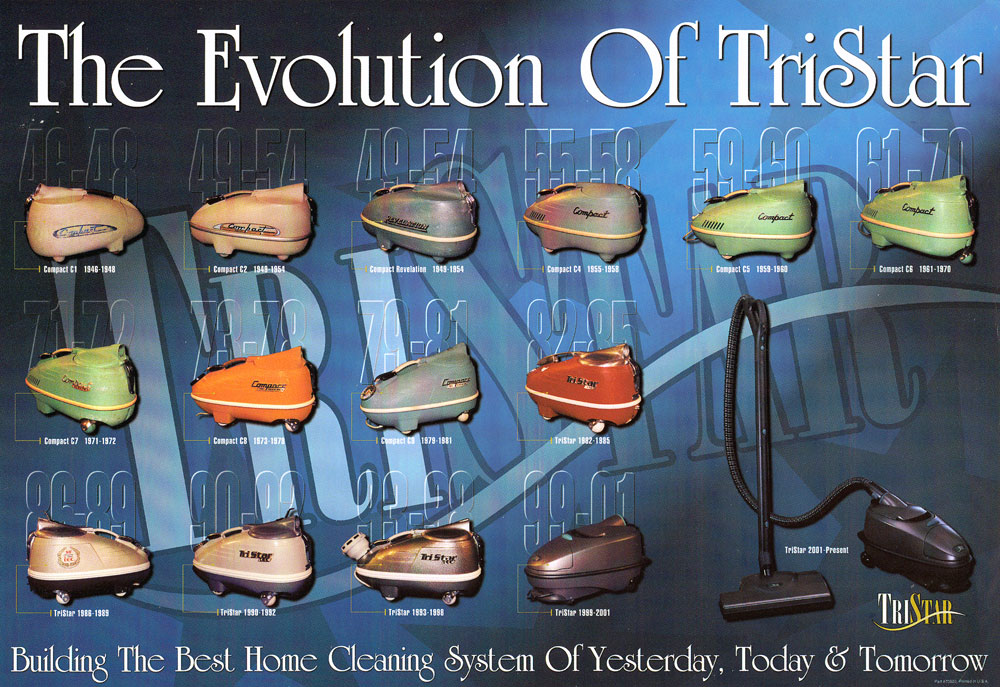
| ||
| Post# 128226 , Reply# 48 3/22/2011 at 20:31 (4,875 days old) by kenkart () | ||
|
I see one mistake in the pics! What they show as a c5 is a c4, there were 2 c4s, one with a flat lid and the next one with the regular lid, the c5 had 1 ball caster, the c6 had 2, I have one of our old newsletters somewhere, ill see if I can find it. | ||
| Post# 128237 , Reply# 49 3/22/2011 at 21:38 (4,875 days old) by aeoliandave (Stratford Ontario Canada) | ||
 | ||
| Post# 226379 , Reply# 50 4/3/2013 at 22:35 (4,132 days old) by Vac_whisperer () | ||
|
*Bump* I had a lot of fun reading this thread, way back in 2011. I hope you don't mind me giving it a bump, Dave. | ||
| Post# 226386 , Reply# 51 4/3/2013 at 22:49 (4,132 days old) by aeoliandave (Stratford Ontario Canada) | ||

Not at all, Sam. I'm practically blushing...
This is a great feature or the new site modifications and I'm pleased that several folks have already bumped older threads that illuminate the truly vintage machine discussions that were - and are again - an informational hallmark of Vacuumland over the years. Searching them out was doable but time consuming for some and now the best of the best are easily resurrect-able. Dave | ||
| Post# 226388 , Reply# 52 4/3/2013 at 22:56 (4,132 days old) by Vac_whisperer () | ||
|
That's what I love about this community. So many people willing to share their knowledge. | ||
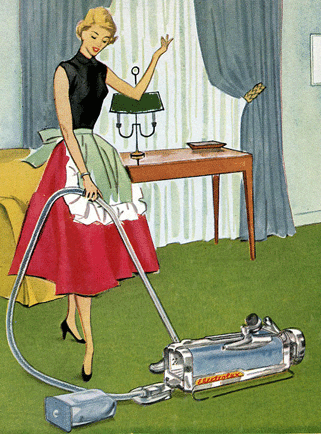
 Comes to the Rescue!
Comes to the Rescue!